Unusual snowmobile machinery of the Soviet Union
 Bashny.Net
Bashny.Net
The idea to adapt to the movement of trucks in the snow appeared long ago.
The first snowmobile was built in Russia in 1904 as an engineer SS Nezhdanovskim. The model is a lightweight sled on which you install an internal combustion engine with an aerodynamic propeller - propeller.
Already in 1907 the Moscow factory "Dux" was built and tested a "ski car" YA Meller, designed jointly with the engineer A. D. Dokuchaev. A year later, the car was named snowmobile. A great contribution to sanestroenie introduced and Igor Sikorsky.
Original theme here: omega.gorod.tomsk.ru/index-1285837465.php
Author: Victor (Le Français ordinair)
the theme is taken here
40 images + letter
01 - The first snowmobile Sikorski.

The second snowmobile Sikorski.
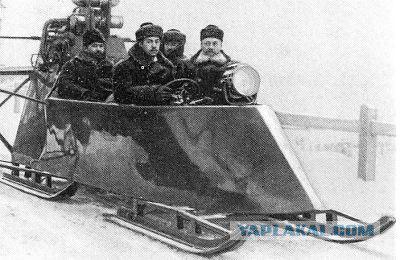
Snowmobiling on the streets of St. Petersburg. Postcard 1914.

1911. Snowmobiling Comte de studdingsail. After appearing in 1904 the world's first snowmobile at Nezhdanovskogo appear hundreds of followers. In the early 1910s snowmobile ceased to be a novelty not only in Russia but also in snowy regions of Austria, France and Germany. In the photograph, taken in April 1911, the Comte de studdingsail snowmobile. This apparatus is strongly reminiscent of German cars of the time, unfortunately, did not survive any information.

The invention of Russian engineers has been invaluable for Russia, with its grandiose space where snow often lasts for many months. Some remote areas of the North could make available only a mechanical transport.
Since 1912, the Russian-Baltic wagon factory (Riga) has begun mass production of snowmobiles commissioned by the Ministry of War.
During the First World War, more than twenty snowmobiles used in parts of the Russian army for connected and transport operations. We used a snowmobile and the Civil War.
An important place in the history of domestic aerosanestroeniya takes the Commission for the construction of snowmobiles (COMPASS), organized in 1919 by a joint decision of the board of TsAGI (Central hydrodynamic Institute) and automotive Scientific Laboratory (NAL). The Commission was established to solve the Revolutionary Military Council of the Republic to the urgent task of TsAGI buildings 20 snowmobiles for the needs of the Red Army. COMPASS is an all in one experimental design bureau, an experienced and serial factories during its existence (1919-23 gg.) Designed and built a number of snowmobiles.
Since 1924, began to appear metallic model snowmobiles. Aluminum made it possible to build a snowmobile, suitable for regular operation, reducing to a minimum the weight of the structure and it greatly simplified. The use of aircraft engines, air-cooled possible to use a snowmobile as a means to serve the airfields in the winter, for the transportation of mail in Siberia, etc.
A great contribution to the development of metal aerosannogo transport in Russia has brought Andrei Tupolev. They proposed a scheme of kolchugalyuminiya snowmobile, which became a classic. Snowmobiling design Tupolev ANT-IV, ANT-VII, the ANT-X built in series and took part in Arctic expeditions, as well as used for regular transportation of passengers and goods in the Soviet Union.
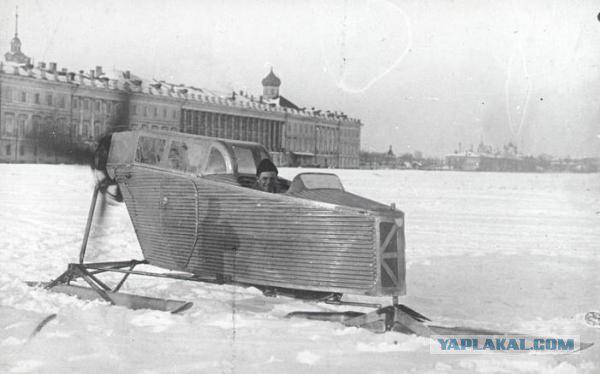
To test snowmobiles and comparative evaluation, a series of runs. In 1926 he held mileage Moscow - Leningrad - Moscow distance of 1,460 km. Attended by 13 sleds. The normal type of sled (100 horsepower, 4 seats) were demonstrated the following characteristics:
average speed over 36 km / h,
maximum speed of 50 km / h,
average fuel consumption per 100 km - 46 kg.
Already in those years one o'clock snowmobile operation costing no more than hours of operation of the vehicle. And this advantage snowmobiles, even more significant in the present conditions to continue in the new models of snow SUV.
The war with Finland in 1939-1940. It allowed the extensive use of commercially produced snowmobile type TsAGI-AHT-IV design Tupolev and OSGA-NKL-6 design, NM Andreev. NKL-6, equipped with a machine gun mounted on a rotatable turret, participated in combat operations, patrolled the exposed areas of the front, carrying outposts facilities.
Due to the high speed and good maneuverability, they were used to identify enemy firing points and adjusting artillery fire in communication between departments, transporting ammunition and food, the wounded were taken. Since February 11, 1940 in the Soviet offensive on the front of the 13th Army between Ladoga and Lake Vuoksa used three aerosannye company. Aerosannye units used during "ice hike" in March 1940 to seize a beachhead on the shores of the Gulf of Vyborg.
Promptly have been created and new machines: sanitary NKL-6C, especially for the evacuation of the seriously wounded on a stretcher to be inserted into the body of snowmobile through the onboard sunroof, staff NKL-38 snowmobile platform NKL-12 * [Sledge NKL-12 were built earlier and only considered for participation in hostilities (eds.)] to serve the airfields - for transportation of fuel in drums, replacement of engines for aircraft, etc.
Use of snowmobiles in combat.

Use of snowmobiles in combat.

Use of snowmobiles in combat.

Use of snowmobiles in combat.

Transportation NKL-16 Division Captain Prokhorov during a combat mission. Winter 1943
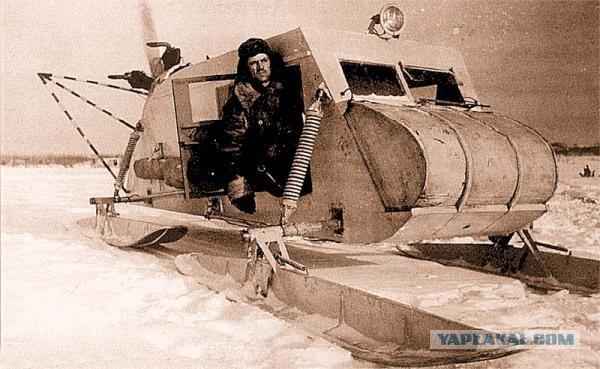
...
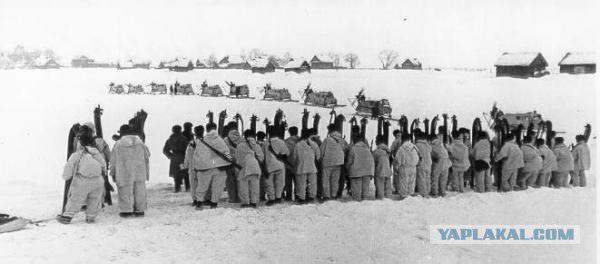
...

...

Snowmobiling in the area of Gzhatsk. Winter 1942-43 biennium.

Landing Scouts NKL-16. Winter 1942-43 biennium.
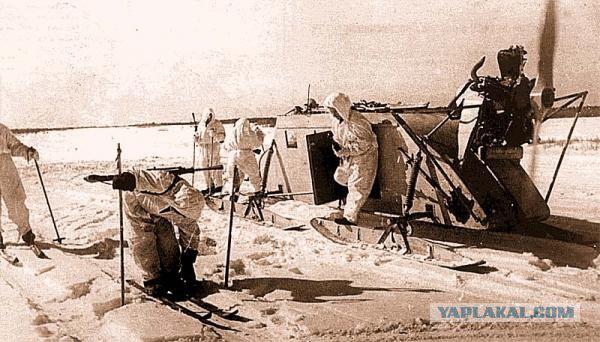
Sanitary NKL-16 model 1937

Snowmobiling RF-8 (GAZ-98) in the battle. 1943
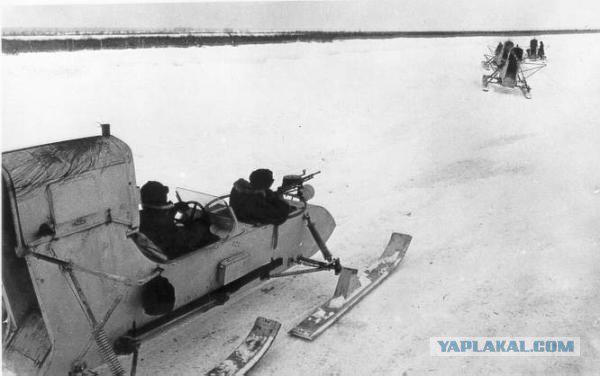
scheme

Graph captured German soldiers learn snowmobile. 1943
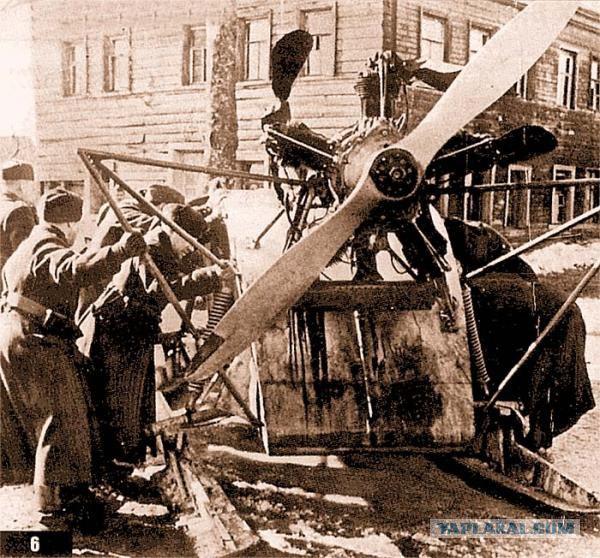
NKL-26 in the summer, "Shine." June 1944

In 1961, the OKB Tupolev group of designers led by GV Makhotkin were issued to the test the first snowmobile amphibian A-3, serial production of which began in 1964 and lasted more than 25 years. A-3 has quickly gained popularity in the northern parts of the country, used in the construction of the Baikal-Amur railway, in the frontier troops. It produced more than 700 cars, some of which were exported abroad.
The 70s theme snowmobile technology has been very popular. There were many snowmobiles, "karakatohodov" and a boat with a propeller.
In the magazine "Model Construction", "Technology of Youth" "Young technician" published numerous options snowmobile equipment. Already at that time there were a lot of good "all-terrain solutions».
Snowmobiling "North-2" and Ka-30 development Kamov design bureau, 1963
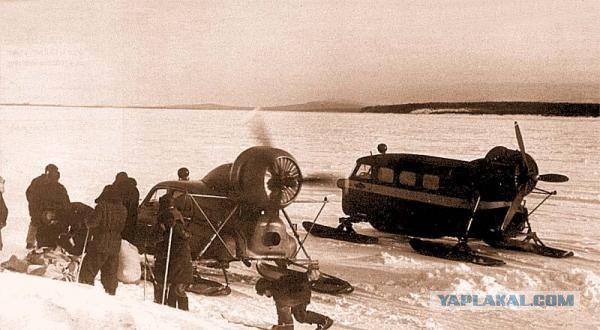
Snowmobiling can be comfortable.
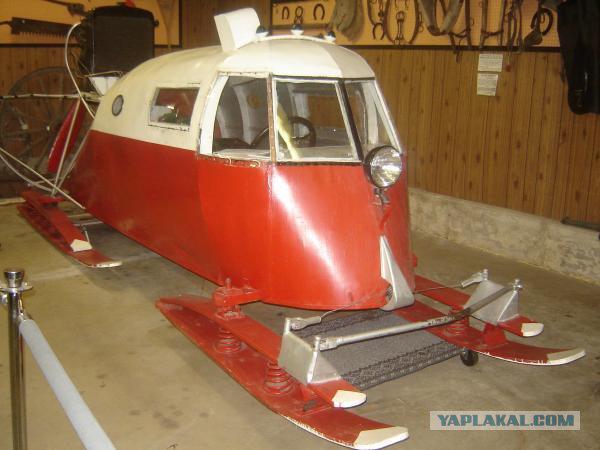
Snowmobiling on the basis of "Victory."

At the request of Brezhnev, who liked Tupolev amphibian A-3, were designed snowmobile length of 4, 5 m, a width of 1, 8 m and a weight of only 400 kg. Quadruple machine was set in motion an engine capacity of 35 hp, but was able to accelerate on snow and water up to 40-50 km / h. It was built three such cars - two of them transferred to the State hunting reserve "Zavidovo", and the third was used based in Dubna, for test purposes.

But not only the snowmobile was used in the Soviet Union as snowmobiles art. A separate area received the so-called Arctic ATVs. With the development of the North, as well as the Arctic and Antarctic Snowmobiling is not able to perform complex tasks on delivery of goods, fuel. First, for this purpose have been established gas trucks crawler.
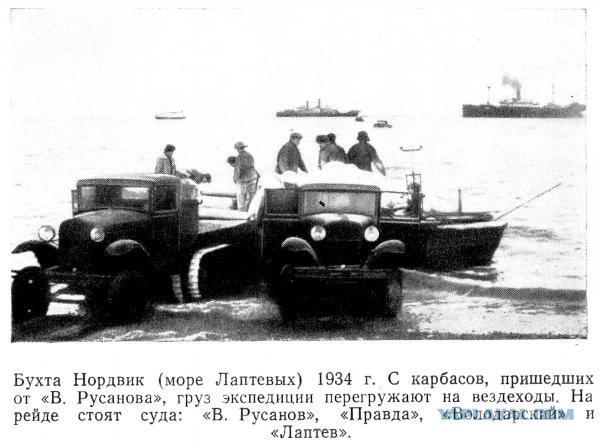
More
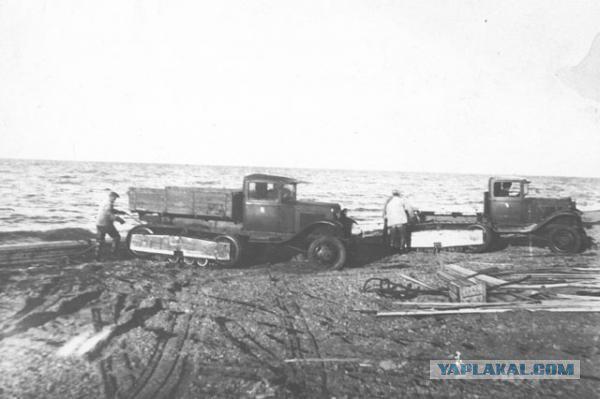
And small ATVs "Studebaker M29 Weasel», delivered in the Soviet Union during the war.
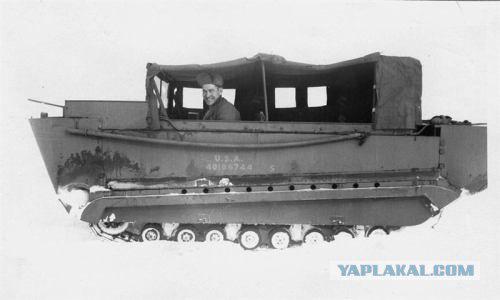
Use the "snow" all-terrain vehicle was planned in 1939, while preparing a new expedition "Polar Admiral" Byrd. It was assumed that the machine is equipped with everything necessary for independent work of the crew of four researchers will be able to get to the South Pole:

The ice machine down the wooden ramp under its own power.

However, already at the station turned out that the wheels sink into the snow, the car almost lying on the "belly". However, it helped a little. The car could barely walk to the station. Despite the lower temperature, the motor overheats, and the rate was just "tortoise". The venture was abandoned, and the body of the car was used as a living and working space station.
"Technology-Youth", 1940.
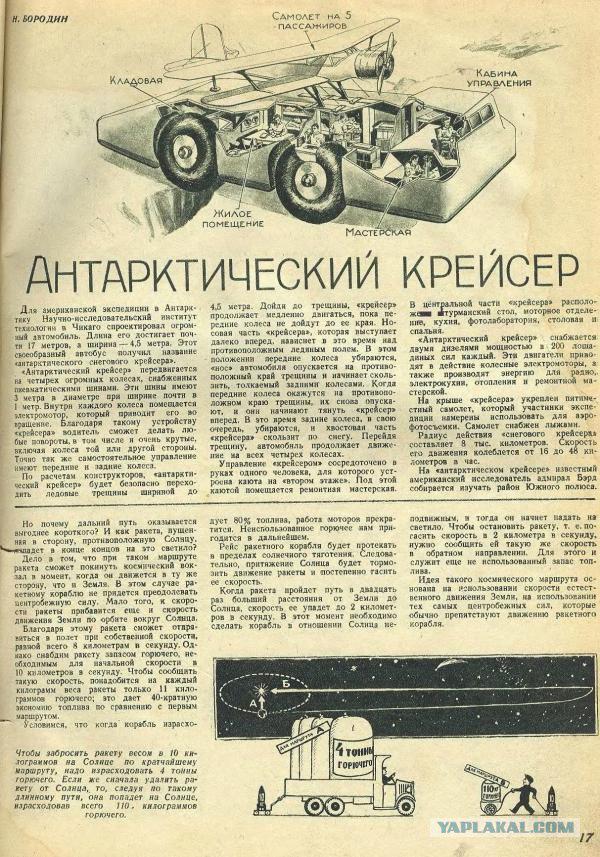
However, similar machines not found in any country in the world is not. They are unique, like a spaceship, as the latest generation supercomputer. Nevertheless, the Guinness Book of Records, they do not fall.
DT-30P, which means "two-tier tracked transporter, load capacity of 30 tons, floating." Successful research in Antarctica has come at a fraction of the Soviet «Kharkov».
Arctic terrain vehicle "Kharkovchanka" used by explorers to the 90s of the last century. One of its functions - tractor in the sledge-caterpillar train for the delivery of fuel and equipment from South Pole station "Peace" to the station "Vostok" (located in the depths of the Antarctic continent at an altitude of 3488 meters above sea level, thousands of kilometers from the coast and from other stations. This cold pole of the planet (at the station recorded the lowest temperature in the world -89, 2 ° C). Even in the summer there is never warmer than -25 ° C. Around the "East" in the thousands of kilometers of nothing but dazzling white ice and snow. sledge-caterpillar train gets here from "Peace" is more than a month)
Arctic terrain vehicle "Kharkovchanka."

schematically

"Kharkovchanka" in the Antarctic expedition.

...
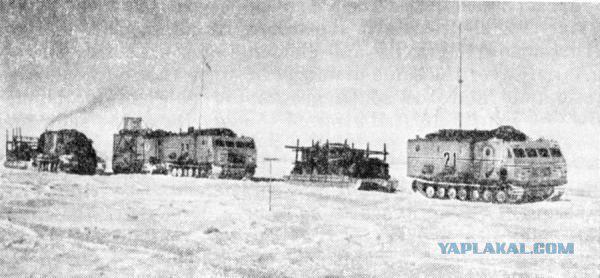
...
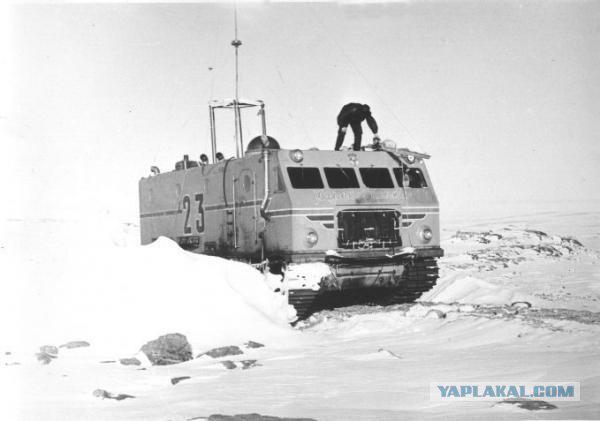
"Harkovchanka-2" on the chassis AT-T, not "integrated" body.
Features:
* Power diesel engine - 995 hp
* Cruising - 1500 km
* Dimensions - length of 8, 5 m, width 3, 5 m, height 4 m
* Maximum speed - 30 km / h
* Climbing rise - 30 °
* The volume of the cabin - 50 m

For the comfortable stay of people in such harsh climatic conditions the interior, too, must be "at the level of»:

And today these amazing ATVs are doing their hard work.
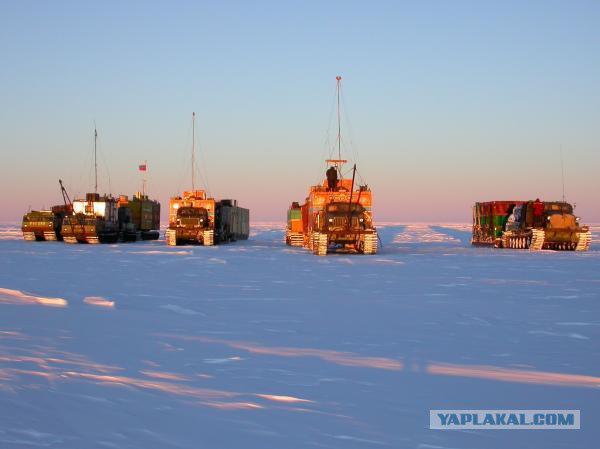
All
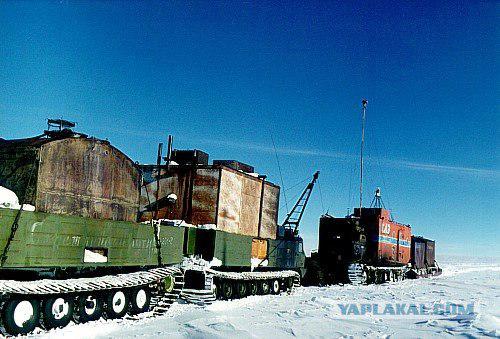
Source:
The first snowmobile was built in Russia in 1904 as an engineer SS Nezhdanovskim. The model is a lightweight sled on which you install an internal combustion engine with an aerodynamic propeller - propeller.
Already in 1907 the Moscow factory "Dux" was built and tested a "ski car" YA Meller, designed jointly with the engineer A. D. Dokuchaev. A year later, the car was named snowmobile. A great contribution to sanestroenie introduced and Igor Sikorsky.
Original theme here: omega.gorod.tomsk.ru/index-1285837465.php
Author: Victor (Le Français ordinair)
the theme is taken here
40 images + letter
01 - The first snowmobile Sikorski.

The second snowmobile Sikorski.

Snowmobiling on the streets of St. Petersburg. Postcard 1914.

1911. Snowmobiling Comte de studdingsail. After appearing in 1904 the world's first snowmobile at Nezhdanovskogo appear hundreds of followers. In the early 1910s snowmobile ceased to be a novelty not only in Russia but also in snowy regions of Austria, France and Germany. In the photograph, taken in April 1911, the Comte de studdingsail snowmobile. This apparatus is strongly reminiscent of German cars of the time, unfortunately, did not survive any information.

The invention of Russian engineers has been invaluable for Russia, with its grandiose space where snow often lasts for many months. Some remote areas of the North could make available only a mechanical transport.
Since 1912, the Russian-Baltic wagon factory (Riga) has begun mass production of snowmobiles commissioned by the Ministry of War.
During the First World War, more than twenty snowmobiles used in parts of the Russian army for connected and transport operations. We used a snowmobile and the Civil War.
An important place in the history of domestic aerosanestroeniya takes the Commission for the construction of snowmobiles (COMPASS), organized in 1919 by a joint decision of the board of TsAGI (Central hydrodynamic Institute) and automotive Scientific Laboratory (NAL). The Commission was established to solve the Revolutionary Military Council of the Republic to the urgent task of TsAGI buildings 20 snowmobiles for the needs of the Red Army. COMPASS is an all in one experimental design bureau, an experienced and serial factories during its existence (1919-23 gg.) Designed and built a number of snowmobiles.
Since 1924, began to appear metallic model snowmobiles. Aluminum made it possible to build a snowmobile, suitable for regular operation, reducing to a minimum the weight of the structure and it greatly simplified. The use of aircraft engines, air-cooled possible to use a snowmobile as a means to serve the airfields in the winter, for the transportation of mail in Siberia, etc.
A great contribution to the development of metal aerosannogo transport in Russia has brought Andrei Tupolev. They proposed a scheme of kolchugalyuminiya snowmobile, which became a classic. Snowmobiling design Tupolev ANT-IV, ANT-VII, the ANT-X built in series and took part in Arctic expeditions, as well as used for regular transportation of passengers and goods in the Soviet Union.

To test snowmobiles and comparative evaluation, a series of runs. In 1926 he held mileage Moscow - Leningrad - Moscow distance of 1,460 km. Attended by 13 sleds. The normal type of sled (100 horsepower, 4 seats) were demonstrated the following characteristics:
average speed over 36 km / h,
maximum speed of 50 km / h,
average fuel consumption per 100 km - 46 kg.
Already in those years one o'clock snowmobile operation costing no more than hours of operation of the vehicle. And this advantage snowmobiles, even more significant in the present conditions to continue in the new models of snow SUV.
The war with Finland in 1939-1940. It allowed the extensive use of commercially produced snowmobile type TsAGI-AHT-IV design Tupolev and OSGA-NKL-6 design, NM Andreev. NKL-6, equipped with a machine gun mounted on a rotatable turret, participated in combat operations, patrolled the exposed areas of the front, carrying outposts facilities.
Due to the high speed and good maneuverability, they were used to identify enemy firing points and adjusting artillery fire in communication between departments, transporting ammunition and food, the wounded were taken. Since February 11, 1940 in the Soviet offensive on the front of the 13th Army between Ladoga and Lake Vuoksa used three aerosannye company. Aerosannye units used during "ice hike" in March 1940 to seize a beachhead on the shores of the Gulf of Vyborg.
Promptly have been created and new machines: sanitary NKL-6C, especially for the evacuation of the seriously wounded on a stretcher to be inserted into the body of snowmobile through the onboard sunroof, staff NKL-38 snowmobile platform NKL-12 * [Sledge NKL-12 were built earlier and only considered for participation in hostilities (eds.)] to serve the airfields - for transportation of fuel in drums, replacement of engines for aircraft, etc.
Use of snowmobiles in combat.

Use of snowmobiles in combat.

Use of snowmobiles in combat.

Use of snowmobiles in combat.

Transportation NKL-16 Division Captain Prokhorov during a combat mission. Winter 1943

...

...

...

Snowmobiling in the area of Gzhatsk. Winter 1942-43 biennium.

Landing Scouts NKL-16. Winter 1942-43 biennium.

Sanitary NKL-16 model 1937

Snowmobiling RF-8 (GAZ-98) in the battle. 1943

scheme

Graph captured German soldiers learn snowmobile. 1943

NKL-26 in the summer, "Shine." June 1944

In 1961, the OKB Tupolev group of designers led by GV Makhotkin were issued to the test the first snowmobile amphibian A-3, serial production of which began in 1964 and lasted more than 25 years. A-3 has quickly gained popularity in the northern parts of the country, used in the construction of the Baikal-Amur railway, in the frontier troops. It produced more than 700 cars, some of which were exported abroad.
The 70s theme snowmobile technology has been very popular. There were many snowmobiles, "karakatohodov" and a boat with a propeller.
In the magazine "Model Construction", "Technology of Youth" "Young technician" published numerous options snowmobile equipment. Already at that time there were a lot of good "all-terrain solutions».
Snowmobiling "North-2" and Ka-30 development Kamov design bureau, 1963

Snowmobiling can be comfortable.

Snowmobiling on the basis of "Victory."

At the request of Brezhnev, who liked Tupolev amphibian A-3, were designed snowmobile length of 4, 5 m, a width of 1, 8 m and a weight of only 400 kg. Quadruple machine was set in motion an engine capacity of 35 hp, but was able to accelerate on snow and water up to 40-50 km / h. It was built three such cars - two of them transferred to the State hunting reserve "Zavidovo", and the third was used based in Dubna, for test purposes.

But not only the snowmobile was used in the Soviet Union as snowmobiles art. A separate area received the so-called Arctic ATVs. With the development of the North, as well as the Arctic and Antarctic Snowmobiling is not able to perform complex tasks on delivery of goods, fuel. First, for this purpose have been established gas trucks crawler.

More

And small ATVs "Studebaker M29 Weasel», delivered in the Soviet Union during the war.

Use the "snow" all-terrain vehicle was planned in 1939, while preparing a new expedition "Polar Admiral" Byrd. It was assumed that the machine is equipped with everything necessary for independent work of the crew of four researchers will be able to get to the South Pole:

The ice machine down the wooden ramp under its own power.

However, already at the station turned out that the wheels sink into the snow, the car almost lying on the "belly". However, it helped a little. The car could barely walk to the station. Despite the lower temperature, the motor overheats, and the rate was just "tortoise". The venture was abandoned, and the body of the car was used as a living and working space station.
"Technology-Youth", 1940.

However, similar machines not found in any country in the world is not. They are unique, like a spaceship, as the latest generation supercomputer. Nevertheless, the Guinness Book of Records, they do not fall.
DT-30P, which means "two-tier tracked transporter, load capacity of 30 tons, floating." Successful research in Antarctica has come at a fraction of the Soviet «Kharkov».
Arctic terrain vehicle "Kharkovchanka" used by explorers to the 90s of the last century. One of its functions - tractor in the sledge-caterpillar train for the delivery of fuel and equipment from South Pole station "Peace" to the station "Vostok" (located in the depths of the Antarctic continent at an altitude of 3488 meters above sea level, thousands of kilometers from the coast and from other stations. This cold pole of the planet (at the station recorded the lowest temperature in the world -89, 2 ° C). Even in the summer there is never warmer than -25 ° C. Around the "East" in the thousands of kilometers of nothing but dazzling white ice and snow. sledge-caterpillar train gets here from "Peace" is more than a month)
Arctic terrain vehicle "Kharkovchanka."

schematically

"Kharkovchanka" in the Antarctic expedition.

...

...

"Harkovchanka-2" on the chassis AT-T, not "integrated" body.
Features:
* Power diesel engine - 995 hp
* Cruising - 1500 km
* Dimensions - length of 8, 5 m, width 3, 5 m, height 4 m
* Maximum speed - 30 km / h
* Climbing rise - 30 °
* The volume of the cabin - 50 m

For the comfortable stay of people in such harsh climatic conditions the interior, too, must be "at the level of»:

And today these amazing ATVs are doing their hard work.

All

Source:
Tags
See also
Studebaker - the war, the rise and collapse of the brand.
Examination: Does freezing Belarusian diesel fuel?
Pneumatic city car
History of cars in the "first razah"
Heading for sell
BMW's history dates
People's Car Prokhorov
Museum of the History of the tractor
Car solar powered – breakthrough or dead end?
100 years later. Displace whether hydrogen cars electric cars
















